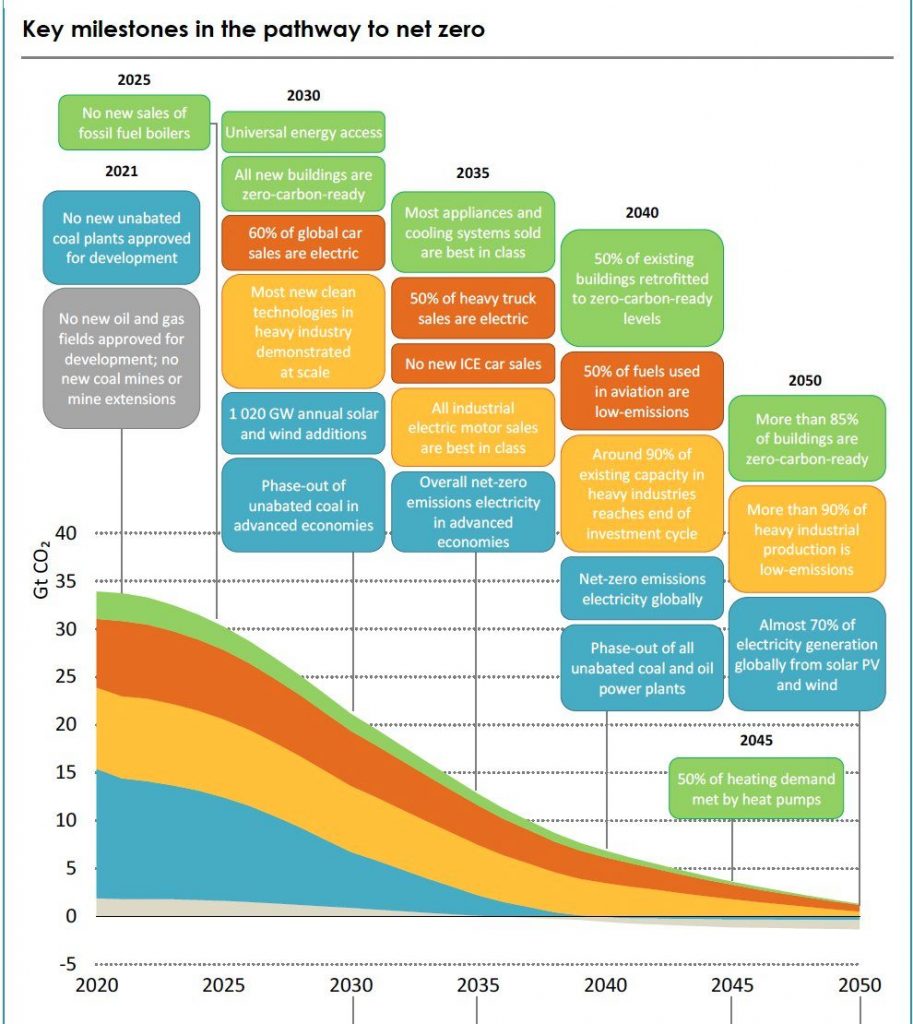Show Time: Stark message from the International Energy Agency
As the 26th Climate Conference (COP26) approaches, there is lots of discussion of the recent IPCC report. There will be a flood of other climate reports landing over the next couple of weeks, from international agencies, environmental groups, industry associations, and many others, all timed for maximum attention at the COP.
But for a concrete understanding of the present situation, the most important analysis is in a report that appeared back in May. The International Energy Agency, at the request of the United Kingdom, did an analysis of what it will take for world emissions to reach net-zero by 2050 – a key milestone for achieving the Paris 1.5°C temperature target, and one that more than 130 countries have adopted, albeit mostly as squishy political declarations, not yet legally binding or implemented.

Statements of urgency for strong climate action are correct and important, but are so numerous that they increasingly seem to get lost in the noise. Even in this crowded field, however, the IEA report stands out for its combination of urgency, specificity, and clarity. The technical substance of the report is impressive, but its importance also has a lot to do with its source: who’s saying it, as much as what they’re saying. The International Energy Agency is a specialist analytic agency established by the rich industrialized nations in the OECD, to advise on energy issues in response to the 1973-1974 oil crisis. It is a highly professional and analytically competent organization, rather conservative, and quite sympathetic to the perspectives and business needs of the energy sector, including fossil-fuel producers. Although it has done excellent climate-related work for many years, environmental groups have usually been highly critical of its projections – for example, in their annual World Energy Outlook – because they have tended to project continued heavy reliance on fossil primary energy, for at least several decades.
Not this time. Compared to IEA’s regular reports, this study reversed the logic. Instead of projecting energy trends forward based on specified assumptions about resources, technology, and economic and policy conditions, this one takes the target of global net-zero in 2050 as a constraint, then joins the dots back to the present. It asks what must happen now, in 5 years, in 10 years, and so on, to track a feasible pathway from the present (emissions ~ 40 Gt CO2/yr, removals ~ a few MtCO2/yr), to emissions and removals being equal – net zero – in 2050.
The results were shocking, although in retrospect they perhaps should not have been. After all, 29 years is not a long time to go from 40 Billion tons to net zero (or to be more precise, to go from 40 Billion to 7.6 Billion tons, with those residual emissions from the hardest-to-cut sources fully offset by carbon capture or negative emissions).

How do they get there? It’s worth reading through their roadmap in detail, but it’s a few of the most immediate requirements that jump out at you. To reach net-zero 2050 via this scenario, approvals and investments in new production facilities for coal, oil, and natural gas – and for coal-burning plants without carbon capture – must stop (wait for it) as of the end of 2021. That’s the end of THIS YEAR! There are similarly mind-focusing milestones throughout the scenario, such as the phaseout of new cars and light trucks with internal-combustion engines by 2035, and the closure of all remaining unabated coal and oil-burning power plants by 2040. Replacing the whole world’s energy infrastructure is slow, and the changes required to achieve the net-zero 2050 goal are enormous. It is thus no longer possible to keep putting off the hard stuff and count on catching up later. We’ve been doing precisely that for 30 years, so all that comforting lead-time has already been used up.
The report is careful to point out that it describes just one scenario to get from here to the goal, and makes no claim that this is the only way. You could, for example, imagine an alternative scenario with much faster scale-up of carbon removal, reaching annual removals of 20 or 30 GtCO2 annually by 2050, rather than this scenario’s assumed 7.6 Gt. These higher removal rates are more typical of scenarios that meet the 1.5°C target. But the assumed rates of scaling carbon removal in those other scenarios have raised a lot of concern about their feasibility and impacts, and the IEA report’s lower assumption appears to be more confidently achievable. You could also put off large reductions a few more years (not many), if those then proceed at an even more rapid rate. But that approach also raises problems, most seriously that it would risk enabling yet another delay *not* followed by extreme rates of reduction. All in all, it is unlikely that other scenarios to reach the same goal will be markedly different in their immediate requirements.
Given this shocking message, the responses were mostly predictable, but with a few interesting wrinkles. Environmental groups mostly praised the rapid phasedown of fossil fuels, but also criticized the report for being too conservative in assuming only 90 per cent renewable electricity generation, and for the scenario’s substantial reliance on growth in nuclear power, carbon capture, and biofuels. Fossil enterprises and political leaders in major fossil producers ranged from politely dismissive to openly contemptuous. OPEC leaders warned that such early restrictions would drive oil prices through the roof – which current energy-market disruptions suggest may well be possible. The Saudi Energy Minister called the IEA scenario “the la-la-land scenario.” India’s Energy Minister called it “pie in the sky.” The Australian Resources Minister reported that his country plans to continue coal production and exports for decades. Most fossil-industry executives and industry associations joined in denouncing the scenario as unrealistic, although with a couple of conspicuous exceptions. The CEO of BP, for example, noted that BP is already planning to reduce oil and gas production by 40% over the next decade, and said that the scenario was “in many ways consistent with what we’re doing with the company.”
Two things are notable about the harshest criticisms of the report. First, the fact that it comes from the IEA makes it tough to arbitrarily dismiss the results. Many of the fossil-friendly organizations that hate this report usually rely on IEA reports to support their visions of a long continued lifetime for fossil-fuel production. But it’s a tough position to say, in effect, that we respect the IEA’s authority and expertise, but only when we like the results. They can point out inconsistencies between this report and prior IEA analyses, as many did. But it increasingly looks like this one was not an anomaly, but represents a serious and enduring change of perspective. For example the World Energy Outlook 2021, released just this month, includes the same net-zero scenario, now as one of three, and prominently points out that the other two scenarios with slower reductions are not compatible with net-zero by 2050. The second notable thing about the criticisms is that no critic disputes the core claim that changes this immediate and rapid are essential to meet the net-zero 2050 target. Instead, they dismiss the scenario as too difficult, too costly, impractical, job-destroying, inflationary, and such: in other words, they do accept the necessity of such rapid cuts to meet the net-zero and climate targets, but are implicitly arguing about whether those goals are worth the cost and disruption of pursuing them. OK, let’s have that argument, but let’s have it with awareness of the gravity of the climate risks that are the reason for considering such rapid and disruptive change.
The most interesting responses, particularly if you have a dark sense of humor, came from political leaders in those countries that both position themselves as climate leaders, and have large fossil-fuel production sectors. These vaguely combined pro forma expressions of respect for the IEA and for climate-change targets, with expressions of continued support for their fossil-fuel sectors and attempts at deflection. Norway’s Prime Minister Erna Solberg pointed out that responsibility for the emissions from burning Norway’s fossil fuels lies with its customers – correct in terms of present inventory guidelines, but non-responsive. Canadian Prime Minister Justin Trudeau re-affirmed Canada’s commitment to net zero by 2050 (with an interim cut of 30% by 2030), but also expressed support for the fossil-dependent economies of two western Provinces – and has persisted with near-term policies to support that industry that this analysis would suggest are in tension with the net-zero goal.
These political leaders have all, in various ways, been imagining a world in which one can be both committed to strong and effective climate action, and a vigorous champion of jobs, revenues, and tax bases in the fossil-dependent parts of their jurisdictions. The way to reconcile these two seemingly contradictory positions is to be extremely optimistic about how easily the required changes will emerge spontaneously in response to impersonal market forces, or be achieved through subtle and uncontroversial policy nudges – preferably enacted by your successor – without ever having to forthrightly engage the workers, businesses, and sub-national governments who live on fossil fuels, and tell them that the source of their current prosperity is now doing more harm than good, and needs to be phased down. To paraphrase St. Augustine, they are praying, “Lord, make me Carbon-neutral … but not yet.”
The trouble with this stance, as the IEA analysis starkly shows, is that that later time, “not yet,” is now upon us. Time’s up. Three decades of delay without serious action to start cutting emissions and transition away from fossil fuels have foreclosed many easier, less disruptive paths to doing so. Rapid progress in some technical areas such as solar and wind electricity and electric vehicles is exciting, but has not yet taken a significant bite out of the whole emissions picture. Carbon removal or Negative Emissions technologies absolutely warrant the flood of enthusiasm, research, and investment they are now receiving, but will probably scale too slowly to achieve the Paris targets without substantial “overshoot” – and in any case, can only augment, not replace, rapid emissions cuts. Yes, many published scenarios say that CDR can scale fast enough to meet even the Paris 1.5°C target, but these rely on highly optimistic technical, environmental, and socio-political assumptions that become more implausible with each passing year. In a serious net-zero target, most of the work will be done by emissions cuts, with only the most persistently technically limited activities getting dispensation to keep emitting. This priority is essential to keep the job of CDR manageable in scale, to avoid a reckless gamble, and to prioritize approaches that credibly achieve real removals, that are securely permanent in emissions disposals, and that are just and acceptable in their distribution of environmental and socio-economic impacts.
This leads to a hard message. On the one hand, the world is quite unlikely to achieve the Paris targets, so we are probably facing decades of increasingly severe and disruptive climate impacts as we overshoot 1.5°C and even 2.0°C. The only way to make these targets confidently achievable is to add solar geoengineering to the response mix – a promising but incomplete and controversial response on which I and colleagues have posted previously and will again, but don’t dig into here. On the other hand, this is not a situation in which “a miss is as good as a mile.” Although they are often portrayed as such in efforts to convey the urgency of the situation, the Paris targets do not correspond to known absolute cliffs, beyond which all is lost and further efforts are futile. Even if current emissions-cutting efforts are fighting to limit heating to 2.0°C vs 2.5°C, or 2.5°C vs 3.0°C, those damage-limiting efforts will still bring enormous benefits and are intensely worth fighting for. Every additional year of delay in taking real steps – meaning real reductions in production and use of fossil fuels, prioritizing those with the highest life-cycle emissions; intense development and scale-up of climate-safe technologies across all sectors; and intense testing, deployment, and scale-up of secure, long-lived carbon dioxide removal – means committing our children and grandchildren to an even worse gamble in the climate conditions they will face. The IEA report has made this stark reality harder to dismiss – which is why so many people and organizations that it is calling upon to act urgently are dissembling and trying to ignore it.
So, to all those modern St. Augustines – in Washington, Delhi, Beijing, Berlin, Ottawa, Alberta, and elsewhere – the time is now. Do your jobs. Stop running out the clock or maneuvering for relative advantage. Exercise real leadership to convey the need and urgency to your citizens and bring them along. Take serious action now, using all legal, regulatory, expenditure, and messaging tools available to you. Help the people and communities whose livelihoods are displaced, but not by letting those destructive livelihoods continue beyond the most rapidly feasible phasedown path. Do this now, without waiting for more studies or consultations about the best way to do it – recognizing that the path will be messy, and the specific policy and technology pathways will need adjustment along the way, to strengthen effectiveness and mitigate collateral disruption and damage. This path will be painful and difficult, but the alternative will be much worse
Reader Comments
3 Replies to “Show Time: Stark message from the International Energy Agency”
Comments are closed.







The IEA Report is rather heavily biased toward specific energy industries and its projections are actually far too conservative.
Hi Joe — Alleged bias not clear to me. Where do you think you see it? The scenario portrays a heavily diversified energy mix, with a ton of renewables and efficiency — and also expanded nuclear, CCS, biofuels. Many of the critical reactions amount to, “Our preferred tech could do even more, faster” — or “Our preferred tech can do so much, you should have excluded this other stuff that we don’t like” — OK, either or both of these could turn out to be true for each source. But the analysis is not making claims about limits of feasible expansion for any particular source (except very broadly in their characterization of how much of required cuts can come from presently available tech, vs needs new innovations — always a fuzzy and contestable boundary). The main point, and the key advance, is showing how soon serious action is needed to start throttling down fossil capacity, no matter what tech replaces it. Don’t need to turn it all off today, but do need to stop building new stuff today. That’s a bracingly cold shower.
We have far too many major human problems today that we apparently aren’t evolved enough to prevent or solve, like global warming, pandemics and variants, the overthrow of our democracy, violence and death by misinformation (we have obviously forgotten the WWII lesson about “If you tell a lie big enough and keep repeating it, people will eventually come to believe it” , etc., all out of control today with no easy solutions we are capable of producing and applying with the required urgency.
And the UN Chief just announced: “We’re on track for catastrophic temperature rise.”
So a most important question is whether our best and brightest today can teach and lead us to protect our newest and future generations from out of control consequences of social and political chaos our institutions and older generations enabled, even though we had the greatest opportunities and advantages in history after WWII to prevent these states of chaos?
Indeed, the power of money is a most common denominator that is destroying our civilization, plus the fact that some evolutionary biologists have delcared our brain evolution to be inadequate to deal with some of the most destructive problems we created, plus far too many peoples don’t even follow the Golden Rule – instead it’s money before human race, and we also have about 8 billion humans to share our planet with today.
So, a paramount question should be: have we reached the end of our ability to survive because we don’t have leaders and/or scholars capable of motivating us to protect us from ourselves? Such as:
4 key issues to watch as world leaders prepare for the Glasgow climate summit
https://theconversation.com/4-key-issues-to-watch-as-world-leaders-prepare-for-the-glasgow-climate-summit-170536
So Legal Planeteers, shall we address the imperatives and implement solutions with the required sense of urgency to save the human race in Glasgow or shall “blah blah blah” be our epitaph?